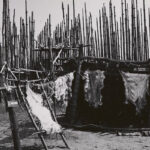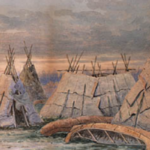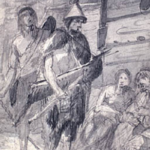Eeyou Istchee: Guardians of the Northern Forest and Keepers of Tradition
The Eeyou Istchee (Cree Nation Government), representing the Cree people of northern Quebec, is a modern embodiment of centuries of cultural resilience, environmental stewardship, and adaptability. The Cree of Eeyou Istchee, part of the Algonquian-speaking peoples, have lived in harmony with the vast boreal forests, rivers, and tundra for millennia. Their history, rooted in ancient traditions and shaped by their interactions with European explorers, the fur trade, and the complexities of modern governance, offers a unique narrative of survival, negotiation, and cultural preservation.
Pre-History: The Cree and the Boreal Forest
The Cree of Eeyou Istchee trace their ancestry back over 5,000 years, with archaeological evidence revealing a long-standing presence in the boreal forests and tundra of what is now northern Quebec and parts of Ontario. Their ancestral territory, referred to as Eeyou Istchee, encompasses an expansive region of forests, rivers, and lakes that provided the foundation for their way of life.
The Cree were semi-nomadic, following a seasonal cycle of movement dictated by the availability of resources. Winters were spent hunting caribou, moose, and small game in the interior forests, while summers brought families together along rivers and lakes to fish, gather berries, and engage in trade and social gatherings. This cycle fostered a deep connection to the land, which was not only a source of sustenance but also a spiritual entity imbued with life and meaning.
Anthropologist Robert Brightman, in Grateful Prey: Rock Cree Human-Animal Relationships, observes, “For the Cree, the boreal forest was not merely a backdrop for survival but a living partner in their existence, demanding respect, balance, and reciprocity.”
Governance and Social Structure
Traditional Cree governance was decentralized, with decisions made collectively by families and bands. Leadership roles, often held by elders or respected hunters, were based on wisdom, experience, and the ability to guide the community through challenges. Chiefs, or Okimaw, provided direction but relied on consensus and cooperation to maintain harmony.
Kinship networks and extended family units formed the backbone of Cree society, ensuring mutual support and resource sharing. Oral traditions passed down stories, spiritual teachings, and practical knowledge, preserving the Cree worldview and cultural identity.
First Contact with Europeans
The arrival of European explorers in the 17th century marked the beginning of sustained contact between the Cree and Europeans. French explorers, including Samuel de Champlain, ventured into Cree territory, drawn by the promise of abundant fur-bearing animals. The establishment of the Hudson’s Bay Company (HBC) in 1670 created a new economic relationship between the Cree and European settlers.
The fur trade became a cornerstone of Cree-European interactions, with the Cree playing a central role as trappers, guides, and intermediaries. The trade introduced new goods, such as firearms, metal tools, and textiles, which enhanced traditional practices while also introducing dependencies. Overharvesting of fur-bearing animals and the spread of European diseases, such as smallpox, brought challenges to Cree society.
Despite these disruptions, the Cree adapted, integrating European goods into their culture while maintaining their traditional practices. Their deep knowledge of the land and waterways made them indispensable partners in the fur trade economy.
Relationships with Missionaries and Settlers
European missionaries, both Catholic and Anglican, established missions among the Cree in the 18th and 19th centuries, seeking to convert them to Christianity. These efforts often clashed with Cree spiritual practices, but many Cree adopted aspects of Christianity, blending them with their existing beliefs. The arrival of settlers and industrial development further disrupted traditional ways of life, leading to conflicts over land use and resource access.
The imposition of the Indian Act (1876) restricted Cree governance and autonomy, confining many communities to reserves and limiting their ability to practice traditional lifestyles. Despite these challenges, the Cree of Eeyou Istchee maintained their cultural identity and continued to rely on their knowledge of the land for survival.
The James Bay and Northern Quebec Agreement (1975)
A defining moment in the history of Eeyou Istchee came in the early 1970s with the proposed development of large-scale hydroelectric projects in northern Quebec. These projects threatened to flood traditional hunting and trapping grounds, displace communities, and disrupt ecosystems. In response, the Cree, along with the Inuit of northern Quebec, organized to protect their lands and rights.
The result was the James Bay and Northern Quebec Agreement (JBNQA) of 1975, the first modern land claim agreement in Canada. The JBNQA recognized Cree rights to their traditional territories, provided compensation, and established governance structures that allowed the Cree to manage education, health, and social services in their communities. It also created the foundation for the modern Cree Nation Government.
Eeyou Istchee Today: Cultural Resilience and Governance
The Cree Nation Government serves as the governing body for the nine Cree communities of Eeyou Istchee, including Mistissini, Waskaganish, and Chisasibi. This governance model blends traditional Cree leadership practices with modern administrative systems, ensuring that the Cree retain control over their lands, resources, and cultural development.
Education, language preservation, and cultural revitalization are central to the Cree Nation Government’s mission. Cree language programs, cultural workshops, and community events celebrate Cree traditions and ensure that younger generations remain connected to their heritage. Hunting, fishing, and trapping continue to play a vital role in community life, sustaining both cultural practices and economic livelihoods.
The Cree Nation Government has also taken a leading role in environmental stewardship. Partnerships with governments and environmental organizations reflect their commitment to sustainable development and the protection of their lands for future generations.
Cultural Revitalization and Environmental Stewardship
The Cree of Eeyou Istchee have demonstrated remarkable resilience in preserving their language, culture, and way of life. Seasonal activities, such as caribou hunts and fishing expeditions, not only sustain the community but also reinforce their connection to the land. Drumming, storytelling, and ceremonies remain integral to community life, fostering a sense of identity and continuity.
The Cree Nation Government’s approach to environmental stewardship reflects traditional ecological knowledge. Programs aimed at protecting water quality, managing wildlife populations, and addressing the impacts of climate change highlight the Cree’s role as guardians of the northern forest.
Conclusion: A Legacy of Strength and Continuity
The history of Eeyou Istchee and the Cree Nation Government is a testament to the resilience, adaptability, and deep connection to the land of the Cree people. From their ancient presence in the boreal forests to their central role in the fur trade and their modern efforts in cultural revitalization and governance, the Cree have maintained their identity and place within Canada’s evolving landscape.
As Grand Chief Abel Bosum stated in a 2018 address, “Our strength lies in our unity, our traditions, and our unwavering connection to Eeyou Istchee. By honouring our past and protecting our land, we build a future for generations to come.”
References
- Brightman, Robert. Grateful Prey: Rock Cree Human-Animal Relationships. University of California Press, 1993.
- Tanner, Adrian. Bringing Home Animals: Religious Ideology and Mode of Production of the Mistassini Cree Hunters. Memorial University of Newfoundland, 1979.
- Cree Nation Government. Eeyou Istchee: A Vision for the Future. Cree Nation Publications, 2015.
- Conrad, Margaret. A Concise History of Canada. Cambridge University Press, 2012.
- James Bay and Northern Quebec Agreement. Modern Treaties in the North. Government of Canada, 1975.
- Environmental Justice Advocacy Group. Guardians of the Boreal: The Role of the Cree in Environmental Advocacy. University of Guelph Press, 2018.
- Johnston, Basil. Ojibway Heritage. McClelland & Stewart, 1976.
- Ridington, Robin. Trail to Heaven: Knowledge and Narrative in a Northern Native Community. Douglas & McIntyre, 1988.
- Neeposh, Thomas. “Protecting Our Lands and Our People: The Vision of the Cree Nation Government.” CBC News, 2021.
- Snow, Dean R. The Iroquois. Blackwell, 1994.



